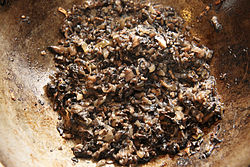

A food paste is a semi-liquid colloidal suspension, emulsion, or aggregation used in food preparation or eaten directly as a spread. [1] Pastes are often highly spicy or aromatic, are often prepared well in advance of actual usage, and are often made into a preserve for future use. Common pastes are some fruit preserves, curry pastes, and nut pastes. Purées are food pastes made from already cooked ingredients.
Contents
- Preparation
- Preservation
- Examples
- Aromatic and spicy
- Cheese and milk
- Fish and meat
- Grain
- Instant soup
- Nut and seed
- Sugar
- Vegetable and fruit
- Yeast extracts
- See also
- Notes
Some food pastes are considered to be condiments and are used directly, while others are made into sauces, which are more liquidy than paste. Ketchup and prepared mustard are pastes that are used both directly as condiments and as ingredients in sauces.
Many food pastes are an intermediary stage in the preparation of food. Perhaps the most notable of such intermediary food pastes is dough. A paste made of fat and flour and often stock or milk is an important intermediary for the basis for a sauce or a binder for stuffing, whether called a beurre manié , [2] a roux [3] or panada. [4] Sago paste is an intermediary stage in the production of sago meal and sago flour from sago palms. [5]
Food for babies and adults who have lost their teeth is often prepared as food pastes. Baby food is often very bland, while older adults often desire increased spiciness in their food pastes.



